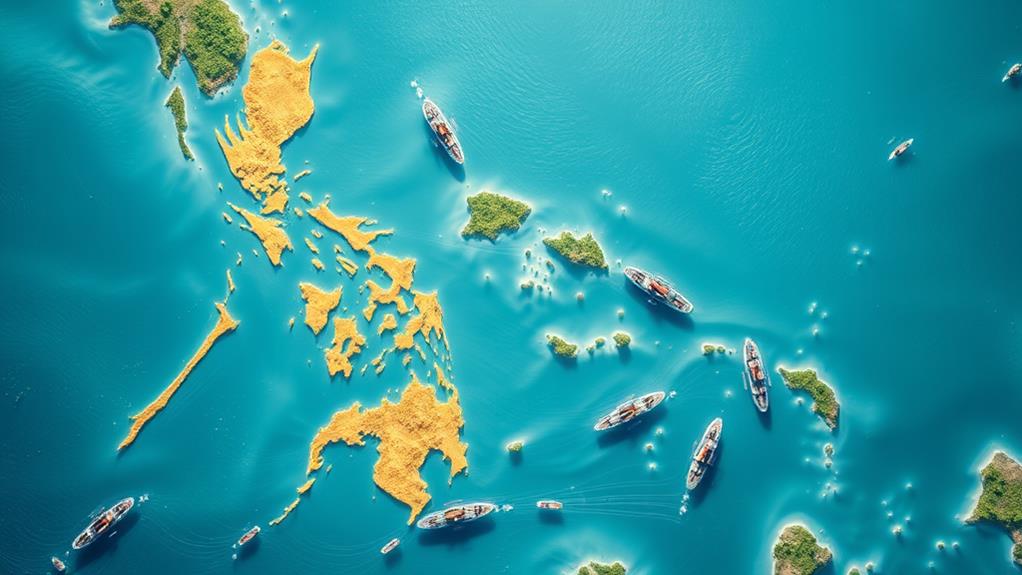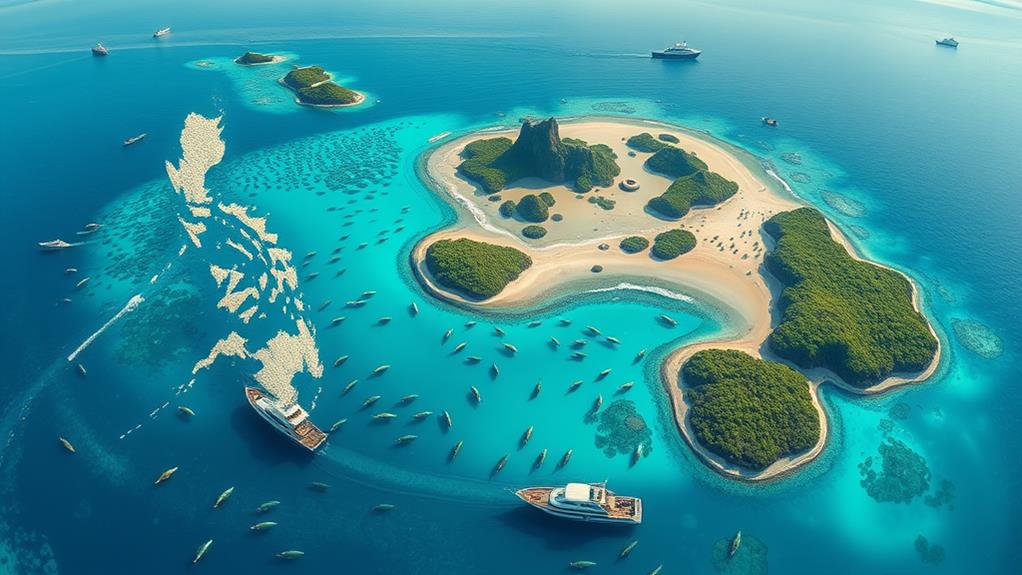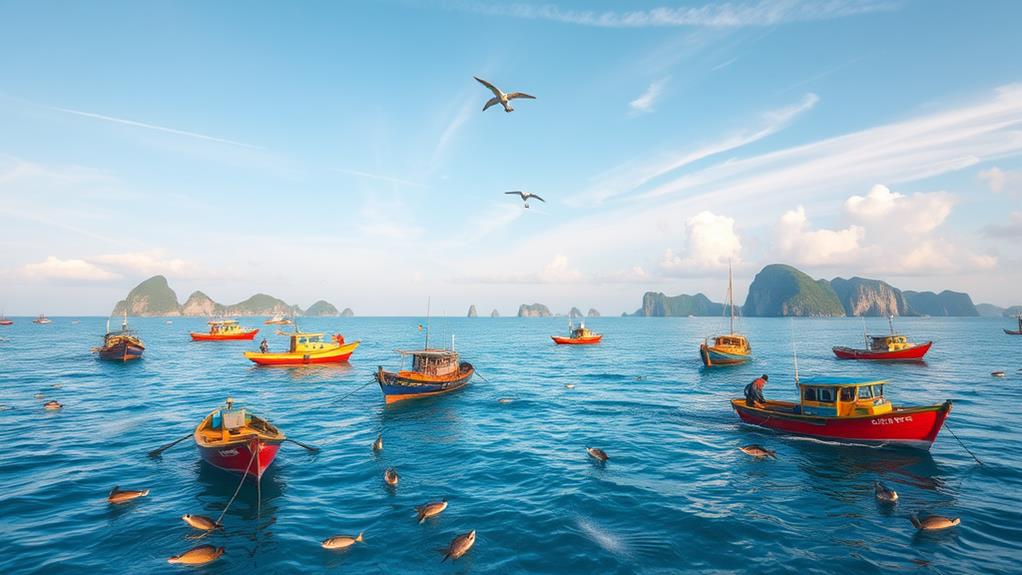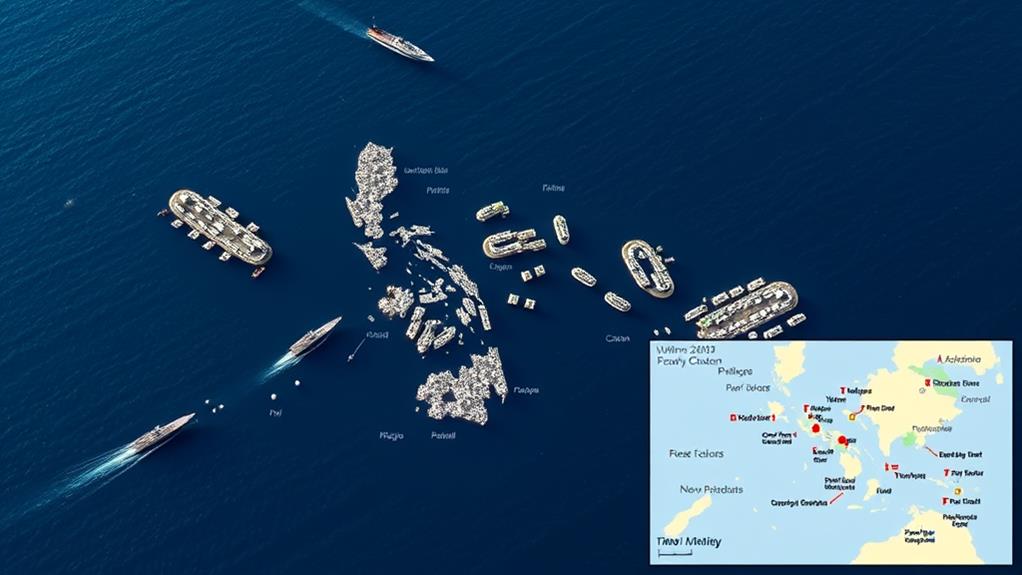The Archipelagic Doctrine: A Key to Protecting the Philippines' Maritime Territory
The archipelagic doctrine, as defined by the United Nations Convention on the Law of the Sea (UNCLOS), treats the Philippines as a single, unified entity. This means that all waters around, between, and connecting its islands are considered internal waters under the country's exclusive sovereignty.
This doctrine allows the Philippines to draw straight baselines to define its territorial sea extent. These baselines enable the country to regulate innocent passage and designate specific sea lanes.
This balance between sovereignty and navigation rights ensures that the Philippines can protect its maritime territory while still allowing for safe and efficient navigation.
The archipelagic doctrine also prevents the dismembering of archipelagos, keeping waters under national control. For example, without this doctrine, other countries could claim parts of the waters between the Philippines' islands, undermining its sovereignty.
By applying this doctrine, the Philippines can better manage its maritime territory, including designating specific maritime zones, implementing environmental protection measures, and developing strategies for fisheries management, law enforcement, and countering maritime threats.
Archipelagic Doctrine Overview

The archipelagic doctrine is a crucial concept in understanding the Philippines' maritime territory.
This doctrine, legally defined by the United Nations Convention on the Law of the Sea (UNCLOS), treats an archipelago as a single unit, rather than separate islands with their own maritime zones. For example, the waters around, between, and connecting the islands of the Philippines are considered internal waters of the state, subject to its exclusive sovereignty. This means that these waters, regardless of their depth or distance from the coast, aren't treated as separate entities but as integral parts of the national territory.
The archipelagic doctrine was a significant achievement for countries like the Philippines, Indonesia, and Fiji. These countries played a key role in its adoption during the UNCLOS negotiations. The doctrine prevents the dismembering of the archipelago, ensuring that the waters between the islands don't become international waters.
This legal framework allows archipelagic states to draw straight baselines connecting the outermost points of the outermost islands, defining the extent of their territorial sea. For instance, the Philippines can draw baselines around its outermost islands to mark the boundary of its territorial sea.
Additionally, it also permits the regulation of innocent passage and sea lanes passage through designated routes, balancing national sovereignty with international navigation rights.
Maritime Territory Definition
The Philippines' maritime territory is defined by the archipelagic doctrine, which establishes specific maritime zones.
The national territory, as outlined in the 1987 Philippine Constitution, includes the Philippine archipelago, islands, and waters within, as well as other territories over which the Philippines has sovereignty or jurisdiction.
This encompasses various maritime zones.
Understanding maritime boundaries and resources is crucial for shaping national identity and heritage. The Pasig River, a critical trade route and vital artery for economic activities, highlights the importance of managing waterways effectively.
Maritime zones in the Philippines include:
Internal Waters: These are the waters landward of the baseline, where the Philippines has full sovereignty and can enforce domestic law.
The Philippines has complete control over these waters.
Territorial Sea: A belt of coastal waters extending up to 12 nautical miles from the baseline, where foreign ships are allowed innocent passage.
Foreign ships can pass through this zone without restrictions.
Exclusive Economic Zone (EEZ): An area extending up to 200 nautical miles from the baseline, where the Philippines has the right to exploit natural resources.
The Philippines has the right to explore and utilize resources in this zone.
Archipelagic Waters: Waters enclosed by the outermost islands of the archipelago, considered internal waters but allowing for innocent passage through designated sea lanes.
These waters are part of the Philippines' internal waters, but with designated routes for foreign ships.
These maritime zones collectively form the Philippines' maritime territory, each with distinct legal and jurisdictional implications.
Understanding these zones is crucial for managing resources, ensuring sovereignty, and resolving territorial disputes.
Environmental Protection Measures

Environmental protection measures are crucial for the Philippines due to its vast marine resources. The country has implemented various initiatives to safeguard its coastal and marine environments. For instance, promoting eco-tourism in unique locations like Hinatuan Enchanted River helps to preserve these areas.
The Philippine Coast Guard plays a vital role in preventing and controlling pollution within territorial waters. Specifically, the Marine Environmental Protection Command (MEPCOM) operates the National Operations Center for Oil Pollution (NOCOP), which coordinates responses to oil spills and other marine environmental incidents.
Legislative efforts have been made to enhance environmental protection. The creation of the Oil Pollution Management Fund (OPMF) in 2007 ensures that resources are available for cleanup operations and damage compensation in case of significant spills.
Additionally, the Philippine government has revised its National Oil Spill Contingency Plan (NOSCP) to better handle spills, with clear protocols for each tier of incident severity.
Efforts to protect biodiversity are underway, particularly in the West Philippine Sea. Initiatives aim to declare protected areas and regulate harmful activities, emphasizing the role of scientists and local governments in conservation.
These measures reflect the Philippines' commitment to balancing maritime security with environmental sustainability.
Mariner Safety and Training
Mariner Safety and Training: A Critical Component of Maritime Security
Ensuring mariner safety and providing adequate training are crucial for the Philippines' maritime security strategy. The country's geographical location and extensive coastlines make it essential to have well-trained mariners who can navigate safely and respond to emergencies effectively.
Virtual Safety Training
The Maritime Industry Authority (MARINA) has successfully conducted virtual Modified Basic Safety Training (MBST) sessions. These sessions include modules on Fire Prevention and Fire Fighting, Elementary First Aid, and Personal Safety and Social Responsibility. This ensures that seafarers on Philippine-registered vessels are properly equipped with essential safety knowledge.
Compliance Inspections
MARINA conducts regular inspections of Philippine flag ships to ensure compliance with safety regulations and international standards. This includes adherence to the Philippine Merchant Marine Rules and Regulations 1997 (PMMRR '97) and the Ship Safety Inspection System (SSIS) manual.
Community Engagement
Military and maritime exercises involve community outreach, such as static displays of marine equipment. This helps foster understanding and support among local residents for the importance of maritime safety and defense.
Advanced Maritime Training
Joint maritime security training exercises with U.S. forces focus on enhancing interoperability and refining operational capabilities. This includes visit, board, search, and seizure (VBSS) drills, which are crucial for maintaining maritime security.
These efforts collectively enhance the safety and proficiency of mariners, contributing to the overall maritime security of the Philippines.
Fisheries Management Strategies

Effective Fisheries Management is Crucial for the Philippines
The Philippines, with its vast marine resources and significant fishing industry, relies heavily on sustainable fishing practices to ensure the long-term health of its fisheries sector.
The Role of the Bureau of Fisheries and Aquatic Resources (BFAR)
The BFAR is the primary agency responsible for managing the country's fisheries. It has established a system of Fisheries Management Areas (FMAs) to co-manage marine resources with local governments.
This framework divides the country's seascapes into 12 areas, each with its own management board to oversee sustainable fishing practices and prevent illegal, unreported, and unregulated (IUU) fishing.
Legal Framework for Sustainable Fisheries
The Philippine Fisheries Code of 1998 and its amendments provide a legal framework for combating IUU fishing and ensuring the sustainability of fishery resources.
The code sets rules for commercial and municipal fishing operations, prohibiting domestic commercial vessels within municipal waters to protect small-scale fishermen.
These measures aim to balance economic needs with environmental sustainability, ensuring that the Philippines' marine resources remain healthy for future generations.
Law Enforcement and Security
Law Enforcement and Security in the Philippines' Maritime Domain
Effective law enforcement is crucial for the Philippines to protect its marine resources and maintain territorial integrity. As an archipelagic nation with over 7,600 islands, the Philippines faces numerous maritime threats, including piracy, terrorism, and illegal fishing.
Lead Agencies
The Philippine Navy, the Philippine Coast Guard (PCG), the Philippine National Police Maritime Group (PNP-MG), and the Bureau of Fisheries and Aquatic Resources are the primary agencies responsible for maritime law enforcement. These agencies work together to ensure the country's maritime interests are protected.
Challenges in Enforcement
Jurisdictional overlap among agencies leads to operational challenges such as miscommunication and turfing. For instance, the PCG and PNP-MG may have overlapping responsibilities in maritime law enforcement, leading to confusion and inefficiency.
Better bureaucratic coordination is necessary to protect maritime interests effectively.
Local Enforcement
Local government units play a crucial role in maritime law enforcement, particularly in enforcing administrative fisheries policies and marine resource conservation within municipal waters. For example, local governments can monitor and regulate fishing activities within their jurisdictions to prevent illegal fishing.
Need for a Strategic Framework
The lack of a comprehensive strategic policy framework for maritime security hinders cohesive action.
The Philippines needs to develop an overarching strategy to coordinate its maritime interests and enforcement measures. This framework would ensure that all agencies work together seamlessly to protect the country's maritime domain.
How Does the Archipelagic Doctrine Help Protect Against Piracy and Illegal Fishing in the Philippines?
The Archipelagic Doctrine plays a crucial role in enhancing maritime security in the philippines. By defining the country’s archipelagic baselines, it helps to establish clear boundaries and regulations for its waters. This framework enables better surveillance and enforcement against piracy and illegal fishing, protecting the Philippines’ maritime security.
Countering Maritime Threats

The Philippines faces various maritime threats, including piracy, terrorism, illegal fishing, and marine pollution.
To counter these threats, the Philippines is enhancing its maritime security and diplomacy. President Ferdinand Marcos Jr. has issued a presidential order to boost defense capabilities and diplomatic efforts, particularly in the face of escalating disputes with China in the South China Sea.
Protecting marine ecosystems is crucial for sustaining local livelihoods. The rich biodiversity in the Sierra Madre region highlights the importance of preserving marine habitats.
Strengthening defense capabilities is key to countering maritime threats. The Philippines is bolstering its defense by:
- Strengthening coordination with allies and partners, such as the United States, Japan, Australia, and the European Union
- Modernizing the naval and coast guard fleets
- Incorporating advanced surveillance systems
- Conducting joint maritime patrols and exercises
Enhancing diplomatic efforts is also crucial. The Philippines is:
- Collaborating with Vietnam to promote a unified stance against aggression
- Leveraging international laws to resolve disputes
- Signing agreements with countries like New Zealand to enhance maritime cooperation and secure vital sea lines of communication
These measures aim to safeguard the country's territorial integrity and ensure the peaceful existence of its citizens.
Regional Stability and Cooperation
To maintain regional stability, the Philippines is actively engaging in cooperative measures with neighboring countries and international partners. This approach is crucial in countering the increasing assertiveness of China in the South China Sea and ensuring the security of vital sea lines of communication.
Enhanced Defense Alliances: The Philippines has strengthened its defense alliances with traditional partners like the United States, Japan, and Australia, and is also building new partnerships with countries such as Vietnam and India.
For instance, the recent Reciprocal Access Agreement with Japan allows for larger and more complex joint military exercises, enhancing regional security.
Multilateral Cooperation: The Philippines is deepening cooperation within ASEAN to promote a unified stance against maritime aggression.
This includes forging stronger ties with global powers and participating in mechanisms like the Trilateral Cooperation Arrangement in the Sulu-Celebes Sea.
Joint Maritime Operations: Collaborative efforts such as the Maritime Cooperative Activity with the U.S. Navy and joint patrols with the Vietnamese Coast Guard are essential in bolstering maritime security and stability.
These operations enhance interoperability and readiness to address maritime threats.
Legal and Diplomatic Efforts: The Philippines is leveraging international law and norms to challenge China's excessive claims.
By emphasizing China's violations of UNCLOS in international forums, Manila aims to build global pressure for compliance with established rules.
Questions and Answers
How Did the Philippines Advocate for Archipelagic States at Unclos?
The Philippines played a crucial role in advocating for archipelagic states at the United Nations Convention on the Law of the Sea (UNCLOS). The country, along with Indonesia, proposed recognizing archipelagos as single units with internal waters at the 1958 and 1960 conferences.
Their persistence led to the inclusion of the archipelagic principle in Part IV of the 1982 UNCLOS, despite initial resistance from other nations.
This recognition was significant because it allowed archipelagic states to treat their waters as a single unit, rather than individual islands.
The Philippines' efforts ensured that these states would have greater control over their internal waters and the ability to manage their resources more effectively.
What Historical Treaties Support the Philippines' Territorial Claims?
Historical treaties support the Philippines' territorial claims. The 1898 Treaty of Paris and the 1900 Treaty of Washington are two significant agreements that back the country's sovereignty.
The 1898 Treaty of Paris ceded the Philippines from Spain to the United States. This treaty marked the beginning of US rule over the Philippines, setting the stage for the country's territorial boundaries.
The 1900 Treaty of Washington clarified the scope of the Philippine territory. Specifically, it stated that all islands within the Philippine Archipelago, including those outside the initial treaty lines, belonged to the Philippines.
This clarification is crucial in establishing the country's sovereignty over disputed areas, such as the Spratly Islands.
Can Foreign Vessels Exercise Innocent Passage Through Archipelagic Waters?
Foreign vessels can exercise innocent passage through archipelagic waters. This right is granted by the Law of the Sea Convention, allowing ships of all states to pass through these waters under certain conditions.
The passage must be continuous and expeditious, meaning it shouldn't be interrupted or delayed. Additionally, the passage mustn't be prejudicial to the coastal state's peace, good order, or security.
However, the archipelagic state has the right to temporarily suspend this right for security reasons. In such cases, the suspension must be published, informing other states and vessels of the restriction.
How Does the Archipelagic Doctrine Impact International Navigation Rights?
The archipelagic doctrine significantly impacts international navigation rights. This doctrine allows archipelagic states to designate certain waters as archipelagic waters, which are subject to specific navigation rules.
Archipelagic waters are waters enclosed by straight baselines that connect the outermost points of the archipelago.
Compliance with navigation rules is mandatory. When navigating through archipelagic waters, ships must comply with the requirement for innocent passage.
Innocent passage means that ships can't engage in activities that are prejudicial to the coastal state's peace, good order, or security. This includes refraining from military exercises, weapons practice, or other activities that could be seen as a threat to the coastal state.
Specific rules apply to submarines and other underwater vehicles. These vessels must navigate on the surface and show their flag, ensuring transparency and adherence to international law.
This requirement helps to prevent clandestine operations and promotes maritime security.
What Role Do Bilateral Negotiations Play in Archipelagic State Recognition?
Bilateral negotiations are essential in recognizing and regulating specific rights and activities within archipelagic waters of archipelagic states.
These negotiations primarily focus on regulating traditional fishing rights and existing agreements between the archipelagic state and its neighboring states.
For instance, an archipelagic state may negotiate with its neighboring state to allow its fishermen to continue fishing in specific areas, under mutually agreed terms and conditions.
This ensures that the rights of both parties are respected and managed effectively.